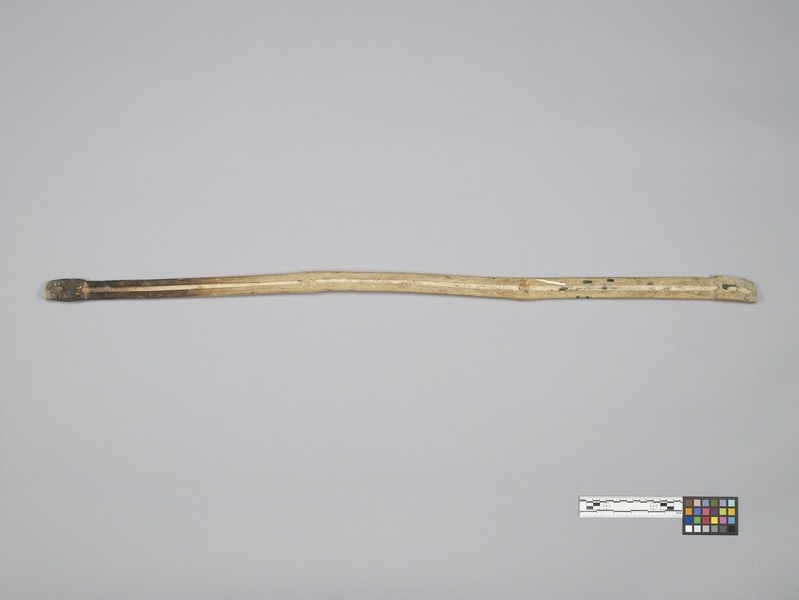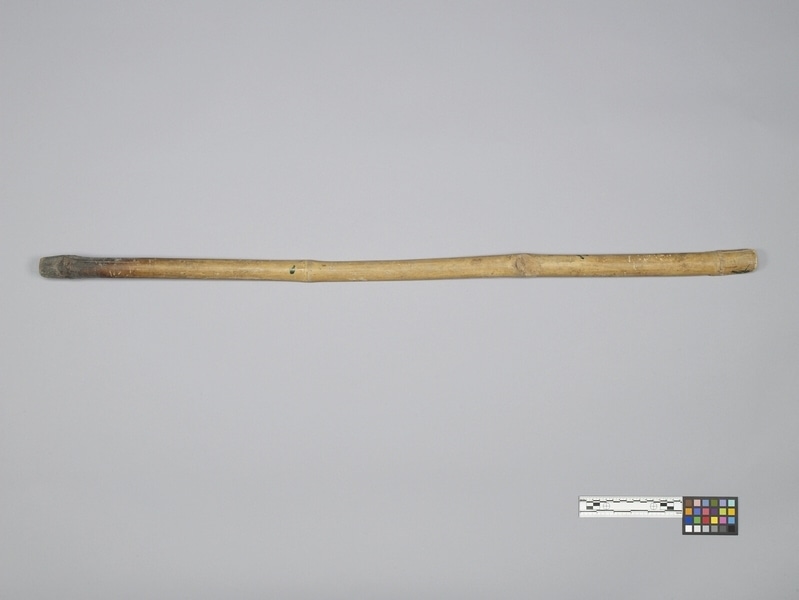Carrying Pole Item Number: Edz1193 from the MOA: University of British Columbia


Description
Length of split bamboo with a slight bend at the centre and slightly thicker ends that taper off.
History Of Use
Small carrying poles of this type were used until about the 1960s by women to carry light loads. They made them themselves as needed. Women used poles like this to carry offerings to worship gods and ancestors, and to carry gifts of food when they went back to visit their natal families at festivals and on special occasions such as weddings. Unlike poles used to carry heavy loads, which women carried on their shoulders, these were carried across their backs. Such a pole would have been used with a pair of special baskets with lids that were used to carry the offerings or foodstuffs. These baskets are sometimes used even now. Examples are Edz1194a-d. After the mid-twentieth century the New Territories of Hong Kong began to undergo fundamental changes. The people who had been settled there before 1898, when the British colonizers claimed the area, began to give up rice agriculture and coastal fishing, turning instead to wage labour and increased employment overseas. By the end of the century, educational opportunities leading to the possibility of white-collar work also increased, together with western influences. Twentieth-century changes meant that objects and clothing once useful and appropriate were no longer needed and generally were discarded. Some were saved by their owners, who sometimes were willing to donate them to museums, sharing, also, their knowledge of how they were made and used.
Narrative
One end of this pole is blackened. According to Mrs. Yau Chan, Shek-ying, this was probably caused by using it to poke a fire in which offerings were being burned. Hakka people are one of the two original land-dwelling groups that settled the area that became the New Territories of Hong Kong. Their spoken language, and some customs, differed from those of the other original group, the Cantonese or Punti. The Cantonese arrived first and settled on the best rice-growing lands, while the Hakka began to arrive after the late 17th century and settled the more hilly lands.
Item History
- Made in Tsuen Wan, Hong Kong, China
- Collected by Elizabeth L. Johnson during 1979
- Owned by Kun-lam Chan
- Owned by Elizabeth L. Johnson before March 17, 1980
- Received from Elizabeth L. Johnson (Seller) and Museum of Anthropology Shop Volunteers (Funding source) on March 17, 1980
What
- Name
- Carrying Pole
- Identification Number
- Edz1193
- Type of Item
- pole
- Material
- bamboo grass
- Manufacturing Technique
- cut, split and smoothed
- Overall
- height 4.2 cm, width 105.8 cm, depth 3.9 cm
Who
- Culture
- Chinese: Hakka
- Field Collector
- Elizabeth L. Johnson
- Previous Owner
- Kun-lam Chan and Elizabeth L. Johnson
- Received from
- Elizabeth L. Johnson (Seller) and Museum of Anthropology Shop Volunteers (Funding source)
Where
- Holding Institution
- MOA: University of British Columbia
- Made in
- Tsuen Wan, Hong Kong, China
When
- Collection Date
- during 1979
- Ownership Date
- before March 17, 1980
- Acquisition Date
- on March 17, 1980
Other
- Condition
- fair
- Accession Number
- 0610/0163